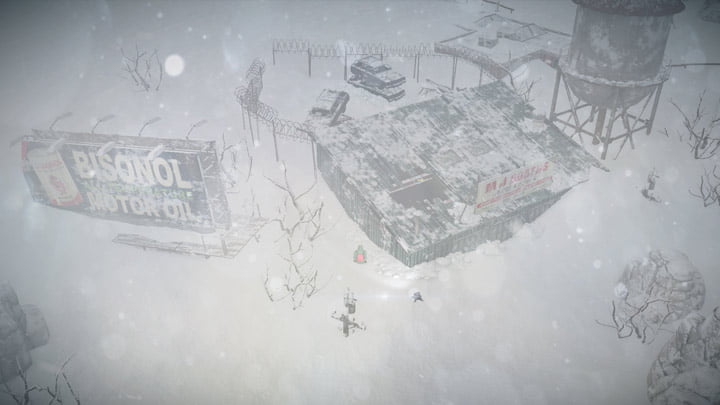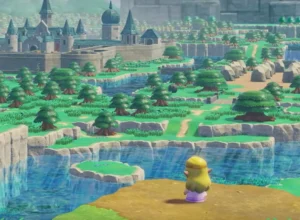Impact Winter is a survival game with the core mechanic – the timeframe, and the notion of what survival means – inverted.
The music is primal. Developer Mojo Bones hot-foots it from John Carpenter’s vault, shouting back “we love your work!” as the alarms sound and the hounds give chase. Upon starting Impact Winter, I woke to the mythic synth baseline of The Thing, with the revelatory chords of Vortex. What a way to frame a game that has you waking in a church – the central hub – as part of a rag-tag group of huddling survivors, before sending you out into the snowy wastes of earth in its twilight hour.
The tutorial puts you through your paces with stabilisers on to build a rhythm: talk to your fellow survivors, assign them tasks, feed them, reinforce the church, search the wilderness, wait for rescue. Completing quests and keeping your band of survivors happy and fulfilled nets you rescue points, lowering the countdown timer bringing you closer to rescue.
This timer frames everything you do, instilling monolithic tension as you trudge through blustering snow drifts. Exploration is where Impact Winter shines. So often with survival games, the fleeting nature of each of their constituent parts leaves you with ants in your pants. You would think here, with the ever-present countdown clock, the church full of survivors to tend to, and the onus on gathering perishable supplies, that there wouldn’t be much room for wide-eyed fun. But there is.
It’s a world half-buried, making discovery a surreal endeavour. Trudging across the milk-white plain and seeing the tips of buildings springing up here and there is eerie. Like caves on an archipelago, these give way to frosted catacombs below with a morbid thrill: there will be supplies and treasures down there, in and amongst the bodies.
There’s something brilliant about a rubbish map as well. Anything that doesn’t clutter my HUD and forces me away from the abstract and pulls my eyes to the world is a force for good. Hyper Light Drifter did this to great effect. I fell in love with that pixel-mess and the vague sense of direction it half-gave; it made that world one of path-finding and landmarks. It’s one that stayed with me.

In Impact Winter, Ako-Light – your floating robot companion – is able to ping radar waves outwards, highlighting items of interest that it can dig up with its laser. But if its battery runs down then all you have is an old-fashioned map of the area as it once was, giving you a vague sense of direction and a sense of archaeological intrigue.
After a while wandering, numbness starts to set in, though it isn’t the cold; it’s the mundane.
There are two things that really trip Impact Winter up: odd design choices and bugs. Morale gets chilly, and you need to keep the home fires burning, literally. This means you’ll have to journey back to the church before long. Whilst you assign roles to your team, they won’t keep the fire burning themselves, and this means going back to top up firewood. You also can’t instruct them to eat or sleep even when they really should. You’ll feel like a worn-down den mother before long.
Inventory management is a wound: whilst it can be an excellent ally in survival games, the decision to not have items stack cumulatively grates. If you need lots of the exact same item, you’ll need to free up a slot for each of them. That makes sense for larger items, but if you need 30 tiny screws? You need 30 empty squares, friend. It feels punitive.
And menu screens are salt in that wound: there are a lot of them, and you’ll be flipping between characters, juggling quests, hitting triggers to get across to character stats and inventory screens. That tutorial is laborious, but it’s absolutely necessary because otherwise you really would be in the wilderness.

Your time in the tundra is meted out with quests. If you want to build a water boiler, you will need the items necessary and will have to off-load them to one of your team. This means doggedly emptying your inventory to ensure you’ve enough space, hunting down the items, and lugging them back for your RP reward. In that time, Ako-Light may run out of battery, meaning you hot-foot back to the church to recharge the little blighter before heading back out before heading back in again. Exploring is intriguing, but doing so with purpose is a pain.
It starts to feel laborious, and it’s shot in the foot with jank: lengthy loading every time you enter buildings, delays in menus, and pauses or non-responses when you push buttons – at least when using a controller for PC. Irritating roughness gives way to more offensive bugs, though: problems with collision detection, animations playing out in the wrong places, people popping into view abruptly.
Mojo Bones is working studiously to patch these problems, and myriad holes have already been plugged, but the game would have greatly benefitted from a delay or two to get it out the door at fighting weight. And these problems hit harder than they would a game with lesser vision.






